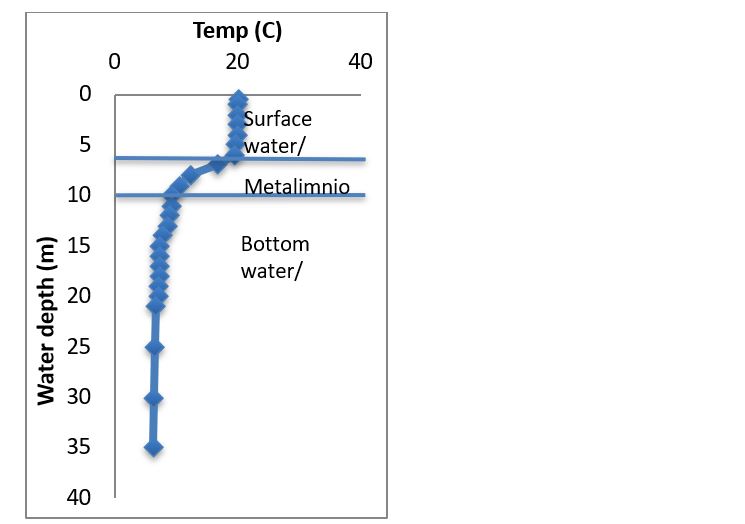This is an appendix to: Huser et al. 2023. Handbook – a decision-support tool for measures against internal phosphorus loading in lakes.
Download pdf-version of appendix 2
Background
The assessment of the risk for elevated internal loading (Step 1 of the tool) and the quantification of internal loading (Step 2) differ between mixed, polymictic and dimictic lakes. Therefore, it is important to know which category a lake belongs to before applying the tool. Note that lake type is not always static and may vary from year to year depending on weather conditions. For instance, it is not uncommon for lakes to be dimictic in some years but polymictic in others. Reference is therefore sometimes made to the stratification conditions of a lake instead of lake type in order to emphasize that a lake may have different stratification regimes from year to year.
The only certain way to ascertain whether the lake is mixed, polymictic or dimictic is to measure the temperature profile at the deepest point of the lake. The measurements should ideally be carried out on a monthly basis between spring mixing (usually between March and May, or after ice out) and the autumn mixing (September to October) to verify that stratification is stable during the summer months (Figure 1).
Identification of mixed lakes with no stratification
A mixed lake is a lake where the entire body of water remains completely mixed throughout the summer. Shallow lakes and lakes with a large water surface are typically well mixed. Water temperature and oxygen levels do not change with depth in such lakes. Phosphorus concentrations are also the same throughout the water column, regardless of depth. If data from sampling of both the surface water and bottom water of a lake are available, these data can be used to assess whether the lake can be deemed to be mixed when the samples were taken. The difference between phosphorus concentrations in surface water and bottom water when taking samples in late summer can be used after ensuring that the lake is not dimictic (see the next section). If the phosphorus level is the same regardless of depth, the water in the lake is considered completely mixed. A slightly higher phosphorus concentration in the bottom water than in the surface water may not give rise to a miscalculation of risk, as the volume of bottom water is generally a small part of the total volume of a lake. Therefore, lakes where the phosphorus level in bottom water < 1.5 x the phosphorus level in surface water can be regarded as mixed with a fair degree of certainty when calculating the risk for elevated internal loading (Appendix 1).
In the absence of data for phosphorus concentration in the lake bottom water, parameters such as oxygen content and water temperature can be used to identify mixed conditions. Under mixed conditions, the bottom water should be oxygenated and there should be little difference in temperature between surface water and bottom water. When taking samples in late summer, a temperature difference between surface water and bottom water of less than 2 °C, or a bottom water temperature > 15 °C, can be used to identify lakes that can be regarded as mixed. The identification becomes slightly more reliable if we add the criterion that oxygen content in the bottom water should be at least 6 mg/l.
For many shallow lakes, data are often only available for the surface water of the lake, or sometimes only for the outlet of the lake. In such cases, lake type cannot be identified on the basis of data for phosphorus concentration, oxygen content or temperature.
Lakes with a maximum depth of 5 m can usually be considered mixed, especially if the Osgood index for the lake is less than 2. The index is calculated as the ratio of the mean depth of the lake to the square root of the surface area of the lake:

However, relying solely on lake geomorphology to assess whether the lake is mixed is much less reliable than an assessment based on profile measurements in the lake.
Dimictic lakes with stable stratification throughout the summer period
The temperature of the bottom water in late summer can be used as a guide in the absence of data from regular measurements of temperature and oxygen profiles. If the bottom water temperature during late summer sampling in July or August is less than 10 °C, it is fairly certain that the lake was stratified during the entire summer period. If the samples were taken in September or October, there is an increased risk that the lake may have been partially or fully mixed, which will lead to the risk of internal loading being underestimated.
Unfortunately, there is no reliable way to identify dimictic lakes using only lake morphology. Lakes for which no bottom water temperature data are available should therefore be regarded as polymictic instead of only be assessed for risk as dimictic lakes.

Polymictic lakes
Many lakes are neither permanently fully mixed nor dimictic but may be alternately stratified and mixed during the summer months. Polymictic lakes are lakes that are usually mixed but may be stratified for short periods. Polymictic lakes never have stable stratification that persists between spring mixing and autumn mixing. The Osgood index for these lakes is generally between 4 and 6 and have a maximum depth of > 5 m. A lake should be classified as polymictic if temperature or oxygen profile data show that the lake is occasionally stratified. Similarly, higher levels of phosphorus in the bottom water (about 1 m above sediment) compared to levels in the surface water indicate that a lake was at least stratified when the samples were taken and has unstable stratification. Low oxygen levels in the bottom water (< 4–5 mg O2/l) also indicate that the lake may be stratified at times. It is likely that the lake is weakly stratified and therefore polymictic if the water temperature 1 m above the bottom is > 10 °C. Unstable stratification means that some of the phosphorus released from the sediment can be transported to the surface water. This would lead to underestimation of internal loading if the lake is regarded as dimictic and only the bottom water is used to calculate the internal phosphorus load.


